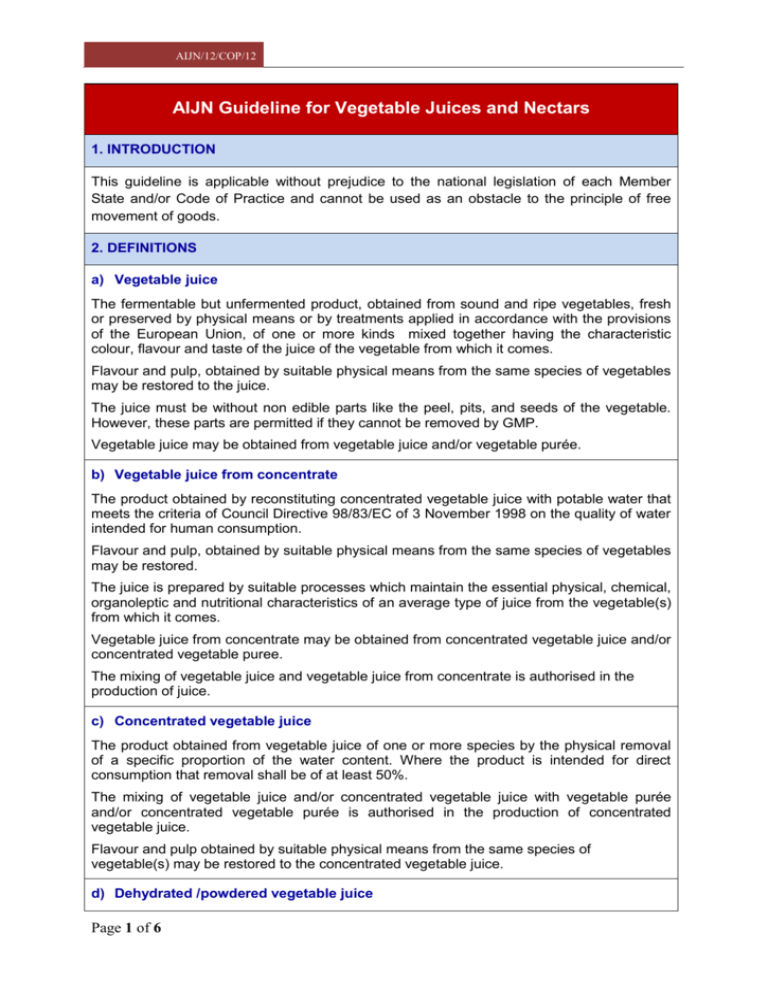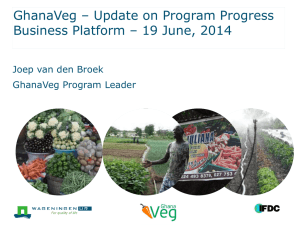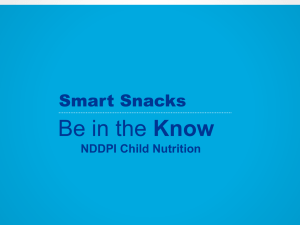AIJN Guideline for Vegetable Juices and Nectars
advertisement

AIJN/12/COP/12 AIJN Guideline for Vegetable Juices and Nectars 1. INTRODUCTION This guideline is applicable without prejudice to the national legislation of each Member State and/or Code of Practice and cannot be used as an obstacle to the principle of free movement of goods. 2. DEFINITIONS a) Vegetable juice The fermentable but unfermented product, obtained from sound and ripe vegetables, fresh or preserved by physical means or by treatments applied in accordance with the provisions of the European Union, of one or more kinds mixed together having the characteristic colour, flavour and taste of the juice of the vegetable from which it comes. Flavour and pulp, obtained by suitable physical means from the same species of vegetables may be restored to the juice. The juice must be without non edible parts like the peel, pits, and seeds of the vegetable. However, these parts are permitted if they cannot be removed by GMP. Vegetable juice may be obtained from vegetable juice and/or vegetable purée. b) Vegetable juice from concentrate The product obtained by reconstituting concentrated vegetable juice with potable water that meets the criteria of Council Directive 98/83/EC of 3 November 1998 on the quality of water intended for human consumption. Flavour and pulp, obtained by suitable physical means from the same species of vegetables may be restored. The juice is prepared by suitable processes which maintain the essential physical, chemical, organoleptic and nutritional characteristics of an average type of juice from the vegetable(s) from which it comes. Vegetable juice from concentrate may be obtained from concentrated vegetable juice and/or concentrated vegetable puree. The mixing of vegetable juice and vegetable juice from concentrate is authorised in the production of juice. c) Concentrated vegetable juice The product obtained from vegetable juice of one or more species by the physical removal of a specific proportion of the water content. Where the product is intended for direct consumption that removal shall be of at least 50%. The mixing of vegetable juice and/or concentrated vegetable juice with vegetable purée and/or concentrated vegetable purée is authorised in the production of concentrated vegetable juice. Flavour and pulp obtained by suitable physical means from the same species of vegetable(s) may be restored to the concentrated vegetable juice. d) Dehydrated /powdered vegetable juice Page 1 of 6 AIJN/12/COP/12 The product obtained from juice as defined under a) b) c) by the physical removal of virtually all the water content. e) X- fermented vegetable juice The product obtained by non-alcoholic fermentation of a vegetable and/or a vegetable juice as defined in 2.a whereby X defines the type of fermentation e.g.: Lactic acid fermented vegetable juice f) X- fermented vegetable juice from concentrate The product obtained by X- fermentation from a vegetable juice from concentrate defined in 2.b) or by reconstituting concentrated fermented vegetable juice as defined under g) with potable water that meets the criteria of Council Directive 98/83/EC on the quality of water intended for human consumption. g) Concentrated x-fermented vegetable juice The product obtained from x-fermented vegetable juice as defined under e) and f) by the physical removal of a specific proportion of the water content. Where the product is intended for direct consumption that removal shall be of at least 50%. A concentrated x-fermented vegetable juice may also be obtained by x-fermentation of a concentrated vegetable juice as defined under c). h) Dehydrated /powdered x-fermented vegetable juice The product obtained from juice as defined under e) f) g) by the physical removal of virtually all the water content. i) Vegetable Nectar The product obtained by adding water with/or without any authorized ingredients as listed in part 3.1. and any authorised additives as listed in part 3.2 to the products defined in point 2 (from a) to h)) and/or to a mixture of those products. Where vegetable nectars are manufactured without added sugar/honey or with reduced energy value, sugars/honey may be replaced wholly or partially by sweeteners in accordance with Regulation (EC) No 1333/2008 on additives. Flavour and pulp obtained by suitable physical means from the same species of vegetables may be restored to the vegetable nectar. The minimum vegetable content is defined in chapter 5. j) Mixture of vegetable and fruit products Any combination of the above defined vegetable products (a) to (h) and fruit juices, fruit nectars and similar products are permitted subject to proper labelling. Examples: Mixed Vegetable and Fruit Juice * Mixed Vegetable and Fruit Nectar * *Fruit juices and fruit nectars as defined in Directive 2001/112/EC, as amended, and vegetable juices and vegetable nectars as defined in this guideline Page 2 of 6 AIJN/12/COP/12 3. INGREDIENTS, TREATMENTS AND SUSBTANCES 3.1 Authorised ingredients Only the following ingredients may be added to the products referred to in Part 2: a) vitamins and minerals as authorized in Regulation (EC) No 1925/2006 on the addition of vitamins and minerals and of certain other substances to foods b) flavours and pulp restored to vegetable juice and to vegetable juice from concentrate must come from the same species of vegetable c) sugars as defined by Council Directive 2001/111/EC, fructose syrup and sugars derived from fruits and vegetables d) honey as defined by Council Directive 2001/110/EC e) for all products defined under section 2. the addition of lemon juice or concentrated lemon juice is permitted as an acidity regulator f) Carbon dioxide, as an ingredient, is permitted g) salt, sea salt or iodized or fluoridated salt and potassium chloride and mixture of them h) herbs, spices and their natural flavourings and extracts i) vegetable derived natural flavourings and vegetable derived extracts j) edible oils k) vinegar l) Drying agent, substances used to dilute or disperse without having a technological role other than to dry and to obtain a dried product 3.2 Authorised additives Additives as authorised in the Regulation (EC) No 1333/2008 on additives; Addition of lactic acid shall not be allowed in lactic acid fermented products and the addition of x acid shall not be allowed in x - fermented products. 3.3 Treatments and authorised substances a) mechanical extraction processes b) the usual physical processes, including in line water extraction(diffusion) of the edible part of the vegetables for the manufacture of concentrated vegetable juices, provided that the concentrated vegetable juices thus obtained comply with part 2 Definitions c) enzyme preparations meeting the requirements of Regulation (EC) N° 1332/2008 d) fermenting micro-organisms e.g. fermentation with lactic acid bacteria e) Edible gelatine f) Adsorbent clays (Bentonite) g) Tannins h) Silicasol i) Nitrogen j) Charcoal Page 3 of 6 AIJN/12/COP/12 k) Calcium carbonate l) Chemically inert filtration aids and precipitation agents (e.g. perlite, washed diatomite, cellulose, insoluble polyamide, polyvinylpolypyrrolidone, polystyrene), which comply with Regulation (EC) N°1935/2004 on materials and articles intended to come into contact with Food m) Other treatments and substances authorized by member states legislations concerning processing aids. 4. DEFINITION RAW MATERIALS a) Vegetable For the purpose of this standard vegetables are the edible parts of root, bulb and tuber vegetables (e.g. carrots, garlic, potatoes) stem and sprout vegetables (e.g. asparagus), leaf and flower vegetables (e.g. spinach, cauliflower), fruit vegetables (e.g. cucumber, pumpkin) and seed vegetables/legumes (e.g. peas) and also rhubarb and others. The vegetables shall be sound, appropriately mature, and fresh or preserved by physical means or by treatments applied in accordance with the provisions of the European Union *Tomato is considered as fruit according to Directive 2012/12/EU amending Directive 2001/112/EC (Annex 2). b) Vegetable purée The fermentable but unfermented product obtained by suitable physical processes without removing the juice. c) Concentrated vegetable purée The product obtained from vegetable purée by the physical removing of a part of the water. d) Vegetable pulp The product obtained in the same way as a vegetable purée whereby a part of the juice is removed. e) Flavour Without prejudice to Regulation (EC) No 1334/2008 flavours for restoration are obtained during the processing of the named vegetable by applying suitable physical processes. These physical processes may be applied to retain, preserve or stabilize the flavour quality and include in particular squeezing, extraction, distillation, filtration, adsorption, evaporation, fractionation and concentration. Page 4 of 6 AIJN/12/COP/12 5. VEGETABLE CONTENT FOR NECTARS Vegetable name Min. Juice/purée content in nectar, % Commentary note: Asparagus 40 Calculation for a multi-juice/nectar. Aubergine 40 Black radish 25 Brussels sprouts 40 The recipe is 60 % carrot, 20 % vegetable paprika, 10 % red beet, 5 % celery root and 5 % leek. How much juice in the final product? Carrot 25 Cauliflower 40 Celery leaves 25 Celery root 25 Chinese cabbage Pe-tsai Carrot 60 % of 250 ml = 150 ml 40 Vegetable paprika 20 % of 400 ml = 80 ml Cos Lettuce 40 Red beet Cucumber 40 10 % of 400 ml = 40 ml Dill 40 Celery root French bean 40 5 % of 250 ml = 12,5 ml Green broccoli 25 Leek Kohlrabi 40 5 % of 250 ml = 12,5 ml Leek 25 Total Lentil 40 295 ml per 1000 ml nectar Lettuce 40 Marrow 40 Onion 25 Parsley leaves 25 Parsley root 40 Pea 25 Potato 40 Pumpkin gourd 25 Radish 25 Red beet 40 Rhubarb 25 Round-headed cabbage 40 Spinach 40 Vegetable paprika 40 Other vegetables (not mentioned in the table) 25 Page 5 of 6 AIJN/12/COP/12 6. LEGISLATIVE CRITERIA The following legislation should be followed: Regulation (EC) 1881/2006 setting maximum levels for certain contaminants in foodstuffs; Regulation (EC) 396/2005 on maximum residue levels of pesticides in or on food and feed of plant and animal origin. 7. LABELLING PROVISIONS The following horizontal legislation should be followed: - Regulation (EC) No 1169/2011 of the European Parliament and of the Council of 25 October 2011 on the provisions of food information to consumers - Regulation (EC) No 1924/2006 on nutrition and health claims made on foods - Regulation (EC) No1334/2008 on flavourings and certain food ingredients with flavouring properties for use in and on foods - Regulation (EC) No 1333/2008 on additives - Regulation (EC) No 1332/2008 on enzymes The following vertical legislation should be taken into account as guiding principle: -Council Directive 2001/112/EC related to fruit juices and certain similar products. Page 6 of 6







